The Gulf Research Program began operations in June 2013, with the formation of a 25-member Advisory Group (page 16) with relevant expertise and experience. The Advisory Group was appointed for 1 year to lead a planning process and create a foundation for the Program. Their work was informed by extensive outreach within the Gulf region and beyond, and their vision is captured in the Program’s strategic plan, The Gulf Research Program: A Strategic Vision (2014).
From June 2013 to December 2014, Advisory Group members heard from more than 400 people from the Gulf region and beyond. (See outreach map.) Meeting participants included representatives from state natural resource agencies, local university researchers and administrators, public health experts, oil industry scientists, and representatives from NGOs. As part of our efforts to learn about relevant issues at the local, regional, and national levels, the Program had a role in more than 35 meetings, workshops, and conferences (see timeline). For example, the Program
- Organized a series of 2-day meetings in each of the Gulf States (AL, FL, LA, MS, TX) to introduce the Program to key stakeholder communities and to begin soliciting advice.
- Sponsored a virtual listening session to begin connecting with potential stakeholders in Alaska to gather perspectives from other regions along the U.S. outer continental shelf where offshore oil and gas production occurs or will occur.
- Hosted four information-gathering meetings in the Gulf and Washington, DC, to interact with representatives from relevant federal agencies, other funding organizations, NGO communities, and from the oil and gas industry.
- Organized three opportunity analysis workshops in the Gulf region (see Highlights of the 2014 Opportunity Analysis Workshop Series) to allow for in-depth exploration of specific topics—developing the Gulf region’s workforce, monitoring ecosystem restoration and deep water environments, and strengthening community health and resilience. The workshops included more than 150 participants from the Gulf states and across the Nation. Summaries can be downloaded from the Gulf Research Program’s website (www.nas.edu/gulf). To date, the summaries have been downloaded more than 1,350 times by people in the Gulf region, across the United States, and other countries.
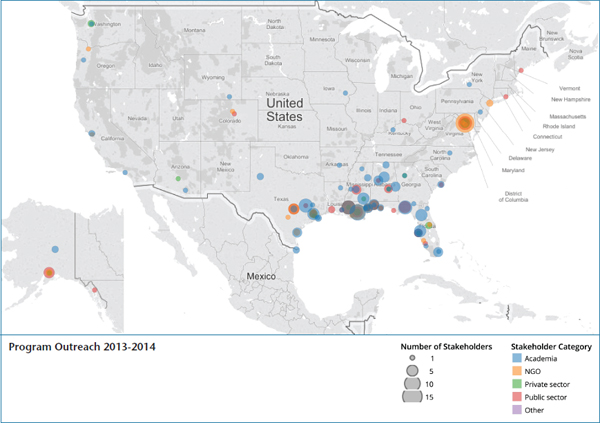
- Engaged funders of restoration programs in discussions about needs related to monitoring restored sites. As a result, the Gulf Research Program is supporting an independent, expert study on Effective Approaches for Monitoring and Assessing Gulf Restoration. (See Restoration Monitoring Consensus Study.)
- Co-sponsored the Gulf of Mexico Research Initiative (GOMRI) Oil Spill and Ecosystem Science conference, which is becoming an annual gathering place for researchers interested in Gulf-related science. At the 2014 GOMRI conference, Gulf Research Program staff co-organized a session focused on “Current and Future Ecosystem-Monitoring Strategies in the Gulf of Mexico,” presented in a session entitled “Socio-economic Analysis of Ecosystem Change: from Baselines to Catastrophic Events,” and co-led a town hall to brief the scientific community about DWH-related funding programs.
HIGHLIGHTS OF THE 2014 OPPORTUNITY ANALYSIS WORKSHOP SERIES
Workforce Education and Training
June 9, 2014, Tampa, FL
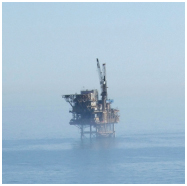
The Gulf region’s workforce consists of many occupations that require considerable skill but not an advanced degree. For example, the oil and gas industry, public health and safety, and environmental restoration organizations depend heavily on such workers. This workshop gathered stakeholders from educational, employer, and policy-making communities to discuss new approaches to educating and training this workforce, which is expected to grow in the Gulf region and nationally.
Workshop participants focused on opportunities related to the offshore oil and gas industry and health professions. The discussions led to the development of one of the Request For Application topics for the Program’s first round of Exploratory Grants.
Monitoring Ecosystem Restoration and Deep Water Environments
September 3-4, 2014, New Orleans, LA
Ecosystem monitoring is a significant challenge as restoration efforts get under way, especially in deep water (i.e., waters deeper than 200 meters and beyond the edge of the outer continental shelf in the Gulf), where much of the new hydrocarbon exploration and development is occurring. This workshop included representatives from the private sector, academia, the NGO community, and federal and Gulf state government agencies.
Workshop participants discussed how understanding of the deep Gulf ecosystem has been stymied in part by its vast scale, its remoteness, and the costs of collecting data in such a challenging environment. One outcome of the workshop was recognition of the importance of data synthesis, which became the focus of one of the Program’s 2015 funding opportunities. Another outcome was the decision to fund a study on better ways to monitor restoration activities.
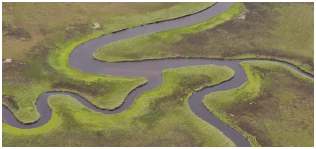
Community Resilience and Health
September 22-23, 2014, New Orleans, LA
Over the Gulf Research Program’s 30-year duration, many factors will influence the health, social well-being, and resilience of Gulf communities. From chronic issues—including health disparities, environmental pollution, and the threat of natural disasters—to the impacts of emerging threats such as rising sea levels and ecosystem change, the Gulf region presents a complex set of challenges to community health and resilience. This workshop brought together individuals from academic institutions; federal, state, and local agencies; and community-based organizations to discuss opportunities to prepare for and respond to these challenges.
Workshop participants discussed what might be learned from the region’s experiences with disasters in the past decade, including droughts that devastated fishing communities, a series of powerful hurricanes, the 2008 economic recession, and the 2010 DWH oil spill. Discussions informed the Program’s 2016 funding opportunities.
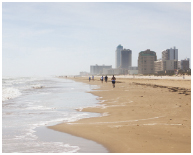
RESTORATION MONITORING CONSENSUS STUDY
In the wake of the DWH oil spill, multiple large restoration efforts have been or will be initiated throughout the Gulf of Mexico region. A wide variety of activities are under way or in planning (e.g., stabilizing and re-establishing marsh habitat to reduce land-loss, creation or reconstruction of oyster beds and reefs, shoreline stabilization, habitat preservation for affected species), and each will have different goals and metrics for success.
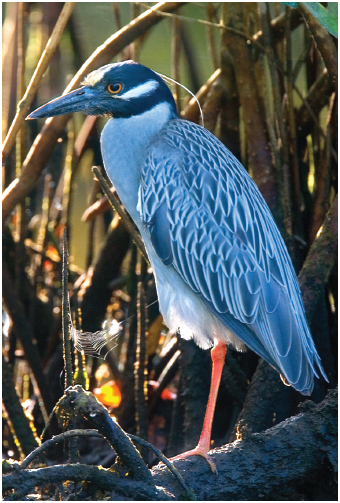
During discussions with organizations involved in restoration, including the National Fish and Wildlife Foundation, the RESTORE Council, and the National Oceanographic and Atmospheric Administration’s (NOAA) RESTORE Act Science Program office, there was significant interest in an Academies consensus study to develop practical guidance for the restoration practitioners as they design their monitoring efforts and metrics.
The study is being conducted by a committee of 15 volunteer experts charged to inform monitoring and evaluation of restoration activities in the Gulf of Mexico, such as identifying best practices (i.e., existing, proven, cost-effective approaches) for monitoring and evaluating restoration activities to improve the performance of restoration programs and increase the effectiveness and longevity of restoration projects. The study began in 2015, and results are expected in late 2016. The committee will identify:
- Current, effective approaches for developing initial and long-term monitoring goals and methods.
- Approaches for determining essential baseline data needs.
- Essential elements of a long-term monitoring framework (including baseline information).
- Additional novel approaches to augment current best practices that could increase effectiveness, reduce costs, ensure regionwide compatibility of restoration monitoring data, and advance the science and practice of restoration.
- Options to ensure that project, or site-based, monitoring could be used cumulatively and comprehensively to provide regionwide insights and track effectiveness on larger spatial and longer temporal scales.




